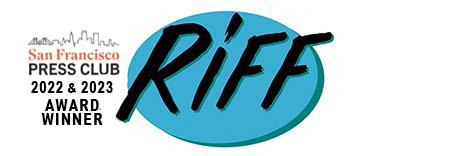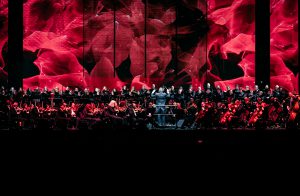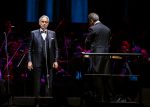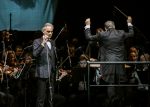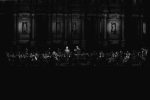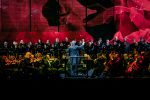Andrea Bocelli makes San Francisco debut with SF Symphony at Chase Center

Andrea Bocelli performs with the San Francisco Symphony and Chorus at Chase Center in San Francisco on Dec. 5, 2019. Photos: Onome Uyovbievbo.
SAN FRANCISCO — As Andrea Bocelli addressed a sold-out Chase Center Thursday night toward the end of his two-hour performance with the San Francisco Symphony, he acknowledged the time that had elapsed since his last Bay Area performance.
Andrea Bocelli
7 p.m., June 13
SAP Center, San Jose
Tickets: On sale Dec. 16.
“It’s a long time that I don’t come here to San Francisco,” said one of the most-talented tenors in the world. “The last time my hair was very black. The hair is changed, but the heart is the same.”
In fact, while he’s sold more than 90 million records, been nominated for several Grammy Awards and at one point simultaneously held the top three positions on the U.S. Classical Albums chart, he’s never performed in San Francisco before.
The 61-year-old Italian may have been sporting slick silver hair, but his passion—and more importantly, his pipes—seemed to be as strong as they are in videos from his breakout decades: the ’80s and ’90s.
Backed by the San Francisco Symphony and a roughly 60-member choir, and supported by numerous guest performers and even two dancers, Bocelli simply dazzled the crowd. The performance, a part of a tour that borrows symphonies in each of the cities he plays, was organized in two parts with an intermission. The first part focused more on his operatic work, while the second on his pop-leaning records and biggest original hits.
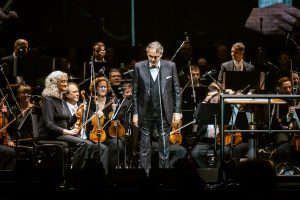
Andrea Bocelli performs with the San Francisco Symphony and Chorus at Chase Center in San Francisco on Dec. 5, 2019.
His 2018 album, Si, debuted at No. 1 on the Billboard 200 chart with guest appearances from the likes of Ed Sheeran and Dua Lipa. It was nominated in the 2020 Grammy Awards for Best Traditional Pop Vocal Album.
The symphony played the part of supporting a actor while the opera singer, songwriter and producer was on stage, but stepped squarely into the spotlight every two or four songs as Bocelli, who is blind, was guided offstage by conductor Eugene Kohn. The show started with the symphony’s rendition of the bombastic “March of the Toreadors,” from the opera “Carmen.” Bocelli made his entrance next to sing “Improvviso,” from 19th-century opera “Andrea Chénier.”
For the third song, and often thereafter during the first part of the show, soprano Larisa Martínez joined Bocelli at the front of the stage for the playful and recognizable “Le donna è mobile,” from Giuseppe Verdi’s opera “Rigoletto.” On “Je vex vivre,” from “Romeo and Juliet,” Martínez skillfully climbed a vocal staircase up and down. On the following “Bimba dagl’occhi pieni di malia,” from Puccini’s “Madame Butterfly,” Bocelli and Martínez faced each other and held each others’ hands during the euphoric crescendos.
The soprano was more animated than the tenor. She communicated through her gesticulations, while his emotion came right from his gut. He would clench his fists and raise his eyebrows, though his arms remained calmly stationary for most of the night.
Recognizable instrumental “Dance of the Hours,” from “La Gioconda,” was performed solely by the San Francisco Symphony and got the sold-out room tapping along to the circus-like rhythm before giving way to the dramatic “Mamma, quel vino è generoso,” from Pietro Masgacni’s opera “Cavalleria rusticana,” and two more opera pieces from Giacomo Puccini’s “La Boheme” and the downright bouncy “Brindisi: libiamo,” from Verdi’s “La Traviata.”
The first part of the show was thoroughly enjoyable, but if anyone walked into intermission wishing to hear something more modern, or sung in English, they were likely to enjoy the second part more. This part included recognizable traditionals like “Ave Maria,” a handful of songs from Bocelli’s 15 solo albums and his two biggest songs.
First, the symphony started the set with a wonderfully nostalgic medley of songs from “The Sound of Music,” including “The Hills Are Alive,” “Do Re Mi” and “Sixteen Going on Seventeen.”
Bocelli returned to the stage, alongside violinist Caroline Campbell, resplendent in a red gown. She joined in a the performance of “Ave Maria” that could make angels cry. Bocelli’s voice has been famously compared to that of God and on this song not many would have disagreed. Two dancers, a man and a woman, performed a choraographed dance that blended ballet, ballroom and modern, of all things. Their movements, alongside Campbell’s violin playing, the tenor’s voice and the symphony and choir behind everyone created such a visual and vocal firework explosion that it was too difficult to determine where best to shoot one’s gaze.
Campbell then led the charge with her violin on the fast-moving and sharp “Gypsy Airs,” by Pablo de Sarasate before Bocelli honored late tenor Luciano Pavarotti with “Voglio Vivere Cosi,” which he had helped to popularize.
For the remainder of the performance Bocelli was joined by singer Pia Toscano (a previous “American Idol” finalist) who sang the Celine Dion lead on “All By Myself,” which the diva had recorded with Bocelli in 1996. The tune was the most pop-centric turn of the night, and it was interesting to see the symphony, which had been going at one speed for the entire show, switch completely. There was pop drumming!
Toscano then stepped in for Ellie Goulding to sing her part on “Return to Love,” Bocelli’s 2019 single. That led into “If Only,” another emotional climax as video behind the symphony and choir played a well-produced video that chronicled Bocelli’s life from 1958—the year of his birth— to 2018, with appearances by his children and wife.
After performing “Canto Della Terra,” which was as lush as the serene imagery on the screen—waterfalls, mountaintops, lakes, rainfall—Bocelli moved on to a few last performances. These were highlighted by the Italian version of “Ode To Joy,” and “Con Te Partiro” and his rendition of “Nessun Dorma,” all of which ended in standing ovations.
The concert moved so quickly that it felt over in a blur. Fortunately, Bat Area fans won’t have to wait another few decades for Bocelli to return. He will headline the SAP Center in San Jose on June 13.
- The San Francisco Symphony and Chorus perform at Chase Center in San Francisco on Dec. 5, 2019.
- Andrea Bocelli performs with the San Francisco Symphony and Chorus at Chase Center in San Francisco on Dec. 5, 2019.
- Andrea Bocelli performs with the San Francisco Symphony and Chorus at Chase Center in San Francisco on Dec. 5, 2019.
- The San Francisco Symphony and Chorus perform at Chase Center in San Francisco on Dec. 5, 2019.
- Andrea Bocelli performs with the San Francisco Symphony and Chorus at Chase Center in San Francisco on Dec. 5, 2019.
- The San Francisco Symphony and Chorus perform at Chase Center in San Francisco on Dec. 5, 2019.
- The San Francisco Symphony and Chorus perform at Chase Center in San Francisco on Dec. 5, 2019.
- Andrea Bocelli performs with the San Francisco Symphony and Chorus at Chase Center in San Francisco on Dec. 5, 2019.
Follow editor Roman Gokhman at Twitter.com/RomiTheWriter. Follow photographer Onome Uyovbievbo at Twitter.com/noitsonome and Instagram.com/ono.photography.
